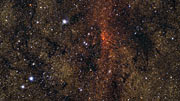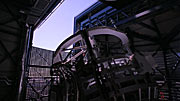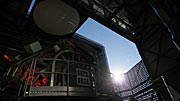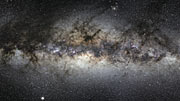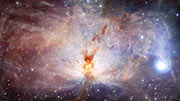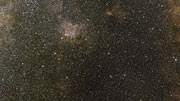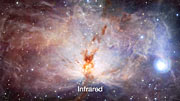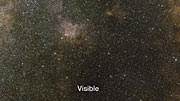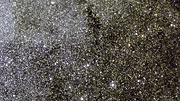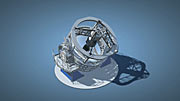Press Release
VISTA: Pioneering New Survey Telescope Starts Work
11 December 2009

A new telescope — VISTA (the Visible and Infrared Survey Telescope for Astronomy) — has just started work at ESO’s Paranal Observatory and has made its first release of pictures. VISTA is a survey telescope working at infrared wavelengths and is the world’s largest telescope dedicated to mapping the sky. Its large mirror, wide field of view and very sensitive detectors will reveal a completely new view of the southern sky. Spectacular new images of the Flame Nebula, the centre of our Milky Way galaxy and the Fornax Galaxy Cluster show that it is working extremely well.
VISTA is the latest telescope to be added to ESO’s Paranal Observatory in the Atacama Desert of northern Chile. It is housed on the peak adjacent to the one hosting the ESO Very Large Telescope (VLT) and shares the same exceptional observing conditions. VISTA’s main mirror is 4.1 metres across and is the most highly curved mirror of this size and quality ever made — its deviations from a perfect surface are less than a few thousandths of the thickness of a human hair — and its construction and polishing presented formidable challenges.
VISTA was conceived and developed by a consortium of 18 universities in the United Kingdom [1] led by Queen Mary, University of London and became an in-kind contribution to ESO as part of the UK's accession agreement. The telescope design and construction were project-managed by the Science and Technology Facilities Council's UK Astronomy Technology Centre (STFC, UK ATC). Provisional acceptance of VISTA was formally granted by ESO at a ceremony at ESO's Headquarters in Garching, Germany, attended by representatives of Queen Mary, University of London and STFC, on 10 December 2009 and the telescope will now be operated by ESO.
“VISTA is a unique addition to ESO’s observatory on Cerro Paranal. It will play a pioneering role in surveying the southern sky at infrared wavelengths and will find many interesting targets for further study by the Very Large Telescope, ALMA and the future European Extremely Large Telescope,” says Tim de Zeeuw, the ESO Director General.
At the heart of VISTA is a 3-tonne camera containing 16 special detectors sensitive to infrared light, with a combined total of 67 million pixels. Observing at wavelengths longer than those visible with the human eye allows VISTA to study objects that are otherwise impossible to see in visible light because they are either too cool, obscured by dust clouds or because they are so far away that their light has been stretched beyond the visible range by the expansion of the Universe. To avoid swamping the faint infrared radiation coming from space, the camera has to be cooled to -200 degrees Celsius and is sealed with the largest infrared-transparent window ever made. The VISTA camera was designed and built by a consortium including the Rutherford Appleton Laboratory, the UK ATC and the University of Durham in the United Kingdom.
Because VISTA is a large telescope that also has a large field of view it can both detect faint sources and also cover wide areas of sky quickly. Each VISTA image captures a section of sky covering about ten times the area of the full Moon and it will be able to detect and catalogue objects over the whole southern sky with a sensitivity that is forty times greater than that achieved with earlier infrared sky surveys such as the highly successful Two Micron All-Sky Survey. This jump in observational power — comparable to the step in sensitivity from the unaided eye to Galileo’s first telescope — will reveal vast numbers of new objects and allow the creation of far more complete inventories of rare and exotic objects in the southern sky.
“We're delighted to have been able to provide the astronomical community with the VISTA telescope. The exceptional quality of the scientific data is a tribute to all the scientists and engineers who were involved in this exciting and challenging project,” adds Ian Robson, Head of the UK ATC.
The first released image shows the Flame Nebula (NGC 2024), a spectacular star-forming cloud of gas and dust in the familiar constellation of Orion (the Hunter) and its surroundings. In visible light the core of the object is hidden behind thick clouds of dust, but the VISTA image, taken at infrared wavelengths, can penetrate the murk and reveal the cluster of hot young stars hidden within. The wide field of view of the VISTA camera also captures the glow of NGC 2023 and the ghostly form of the famous Horsehead Nebula.
The second image is a mosaic of two VISTA views towards the centre of our Milky Way galaxy in the constellation of Sagittarius (the Archer). Vast numbers of stars are revealed — this single picture shows about one million stars — and the majority are normally hidden behind thick dust clouds and only become visible at infrared wavelengths.
For the final image, VISTA has stared far beyond our galaxy to take a family photograph of a cluster of galaxies in the constellation of Fornax (the Chemical Furnace). The wide field allows many galaxies to be captured in a single image including the striking barred-spiral NGC 1365 and the big elliptical galaxy NGC 1399.
VISTA will spend almost all of its time mapping the southern sky in a systematic fashion. The telescope is embarking on six major sky surveys with different scientific goals over its first five years. One survey will cover the entire southern sky and others will be dedicated to smaller regions to be studied in greater detail. VISTA's surveys will help our understanding of the nature, distribution and origin of known types of stars and galaxies, map the three-dimensional structure of our galaxy and the neighbouring Magellanic Clouds, and help determine the relation between the structure of the Universe and the mysterious dark energy and dark matter.
The huge data volumes — typically 300 gigabytes per night or more than 100 terabytes per year — will flow back into the ESO digital archive and will be processed into images and catalogues at data centres in the United Kingdom at the Universities of Cambridge and Edinburgh. All data will become public and be available to astronomers around the globe.
Jim Emerson of Queen Mary, University of London and leader of the VISTA consortium, is looking forward to a rich harvest of science from the new telescope: “History has shown us some of the most exciting results that come out of projects like VISTA are the ones you least expect — and I’m personally very excited to see what these will be!”
Notes
[1] The VISTA Consortium is led by Queen Mary, University of London and consists of: Queen Mary, University of London; Queen's University of Belfast; University of Birmingham; University of Cambridge; Cardiff University; University of Central Lancashire; University of Durham; The University of Edinburgh; University of Hertfordshire; Keele University; Leicester University; Liverpool John Moores University; University of Nottingham; University of Oxford; University of St Andrews; University of Southampton; University of Sussex and University College London.
More information
ESO, the European Southern Observatory, is the foremost intergovernmental astronomy organisation in Europe and the world’s most productive astronomical observatory. It is supported by 14 countries: Austria, Belgium, Czechia, Denmark, France, Finland, Germany, Italy, the Netherlands, Portugal, Spain, Sweden, Switzerland and the United Kingdom. ESO carries out an ambitious programme focused on the design, construction and operation of powerful ground-based observing facilities enabling astronomers to make important scientific discoveries. ESO also plays a leading role in promoting and organising cooperation in astronomical research. ESO operates three unique world-class observing sites in Chile: La Silla, Paranal and Chajnantor. At Paranal, ESO operates the Very Large Telescope, the world’s most advanced visible-light astronomical observatory and VISTA, the world’s largest survey telescope. ESO is the European partner of a revolutionary astronomical telescope ALMA, the largest astronomical project in existence. ESO is currently planning a 42-metre European Extremely Large optical/near-infrared Telescope, the E-ELT, which will become “the world’s biggest eye on the sky”.
Links
Contacts
Prof. Jim Emerson
Queen Mary, University of London
UK
Tel: +44 794 127 1548
Email: j.p.emerson@qmul.ac.uk
Richard Hook
ESO Survey Telescopes PIO
Tel: +49 151 1055 5780
Email: rhook@eso.org
Julia Maddock
Science and Technology Facilities Council
UK
Tel: +44 1793 44 2094
Email: julia.maddock@stfc.ac.uk
Siân Halkyard
Queen Mary, University of London
UK
Tel: +44 20 7882 7454
Email: s.halkyard@qmul.ac.uk
About the Release
| Release No.: | eso0949 |
| Legacy ID: | PR 49/09 |
| Name: | Flame Nebula, NGC 2024 |
| Type: | Milky Way : Nebula : Type : Star Formation |
| Facility: | Visible and Infrared Survey Telescope for Astronomy |
| Instruments: | VIRCAM |
Our use of Cookies
We use cookies that are essential for accessing our websites and using our services. We also use cookies to analyse, measure and improve our websites’ performance, to enable content sharing via social media and to display media content hosted on third-party platforms.
ESO Cookies Policy
The European Organisation for Astronomical Research in the Southern Hemisphere (ESO) is the pre-eminent intergovernmental science and technology organisation in astronomy. It carries out an ambitious programme focused on the design, construction and operation of powerful ground-based observing facilities for astronomy.
This Cookies Policy is intended to provide clarity by outlining the cookies used on the ESO public websites, their functions, the options you have for controlling them, and the ways you can contact us for additional details.
What are cookies?
Cookies are small pieces of data stored on your device by websites you visit. They serve various purposes, such as remembering login credentials and preferences and enhance your browsing experience.
Categories of cookies we use
Essential cookies (always active): These cookies are strictly necessary for the proper functioning of our website. Without these cookies, the website cannot operate correctly, and certain services, such as logging in or accessing secure areas, may not be available; because they are essential for the website’s operation, they cannot be disabled.
Functional Cookies: These cookies enhance your browsing experience by enabling additional features and personalization, such as remembering your preferences and settings. While not strictly necessary for the website to function, they improve usability and convenience; these cookies are only placed if you provide your consent.
Analytics cookies: These cookies collect information about how visitors interact with our website, such as which pages are visited most often and how users navigate the site. This data helps us improve website performance, optimize content, and enhance the user experience; these cookies are only placed if you provide your consent. We use the following analytics cookies.
Matomo Cookies:
This website uses Matomo (formerly Piwik), an open source software which enables the statistical analysis of website visits. Matomo uses cookies (text files) which are saved on your computer and which allow us to analyze how you use our website. The website user information generated by the cookies will only be saved on the servers of our IT Department. We use this information to analyze www.eso.org visits and to prepare reports on website activities. These data will not be disclosed to third parties.
On behalf of ESO, Matomo will use this information for the purpose of evaluating your use of the website, compiling reports on website activity and providing other services relating to website activity and internet usage.
Matomo cookies settings:
Additional Third-party cookies on ESO websites: some of our pages display content from external providers, e.g. YouTube.
Such third-party services are outside of ESO control and may, at any time, change their terms of service, use of cookies, etc.
YouTube: Some videos on the ESO website are embedded from ESO’s official YouTube channel. We have enabled YouTube’s privacy-enhanced mode, meaning that no cookies are set unless the user actively clicks on the video to play it. Additionally, in this mode, YouTube does not store any personally identifiable cookie data for embedded video playbacks. For more details, please refer to YouTube’s embedding videos information page.
Cookies can also be classified based on the following elements.
Regarding the domain, there are:
- First-party cookies, set by the website you are currently visiting. They are stored by the same domain that you are browsing and are used to enhance your experience on that site;
- Third-party cookies, set by a domain other than the one you are currently visiting.
As for their duration, cookies can be:
- Browser-session cookies, which are deleted when the user closes the browser;
- Stored cookies, which stay on the user's device for a predetermined period of time.
How to manage cookies
Cookie settings: You can modify your cookie choices for the ESO webpages at any time by clicking on the link Cookie settings at the bottom of any page.
In your browser: If you wish to delete cookies or instruct your browser to delete or block cookies by default, please visit the help pages of your browser:
Please be aware that if you delete or decline cookies, certain functionalities of our website may be not be available and your browsing experience may be affected.
You can set most browsers to prevent any cookies being placed on your device, but you may then have to manually adjust some preferences every time you visit a site/page. And some services and functionalities may not work properly at all (e.g. profile logging-in, shop check out).
Updates to the ESO Cookies Policy
The ESO Cookies Policy may be subject to future updates, which will be made available on this page.
Additional information
For any queries related to cookies, please contact: pdprATesoDOTorg.
As ESO public webpages are managed by our Department of Communication, your questions will be dealt with the support of the said Department.














